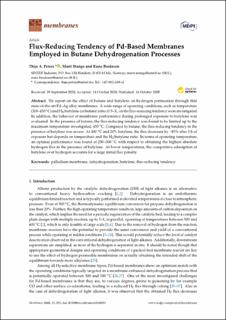Flux-Reducing Tendency of Pd-Based Membranes Employed in Butane Dehydrogenation Processes
Peer reviewed, Journal article
Published version
Permanent lenke
https://hdl.handle.net/11250/3018972Utgivelsesdato
2020Metadata
Vis full innførselSamlinger
- Publikasjoner fra CRIStin - SINTEF AS [5801]
- SINTEF Industri [1565]
Originalversjon
Peters TA, Stange M, Bredesen R. Flux-Reducing Tendency of Pd-Based Membranes Employed in Butane Dehydrogenation Processes. Membranes. 2020; 10(10):291. https://doi.org/10.3390/membranes10100291 10.3390/membranes10100291Sammendrag
We report on the effect of butane and butylene on hydrogen permeation through thin state-of-the-art Pd–Ag alloy membranes. A wide range of operating conditions, such as temperature (200–450 °C) and H2/butylene (or butane) ratio (0.5–3), on the flux-reducing tendency were investigated. In addition, the behavior of membrane performance during prolonged exposure to butylene was evaluated. In the presence of butane, the flux-reducing tendency was found to be limited up to the maximum temperature investigated, 450 °C. Compared to butane, the flux-reducing tendency in the presence of butylene was severe. At 400 °C and 20% butylene, the flux decreases by ~85% after 3 h of exposure but depends on temperature and the H2/butylene ratio. In terms of operating temperature, an optimal performance was found at 250–300 °C with respect to obtaining the highest absolute hydrogen flux in the presence of butylene. At lower temperatures, the competitive adsorption of butylene over hydrogen accounts for a large initial flux penalty.

